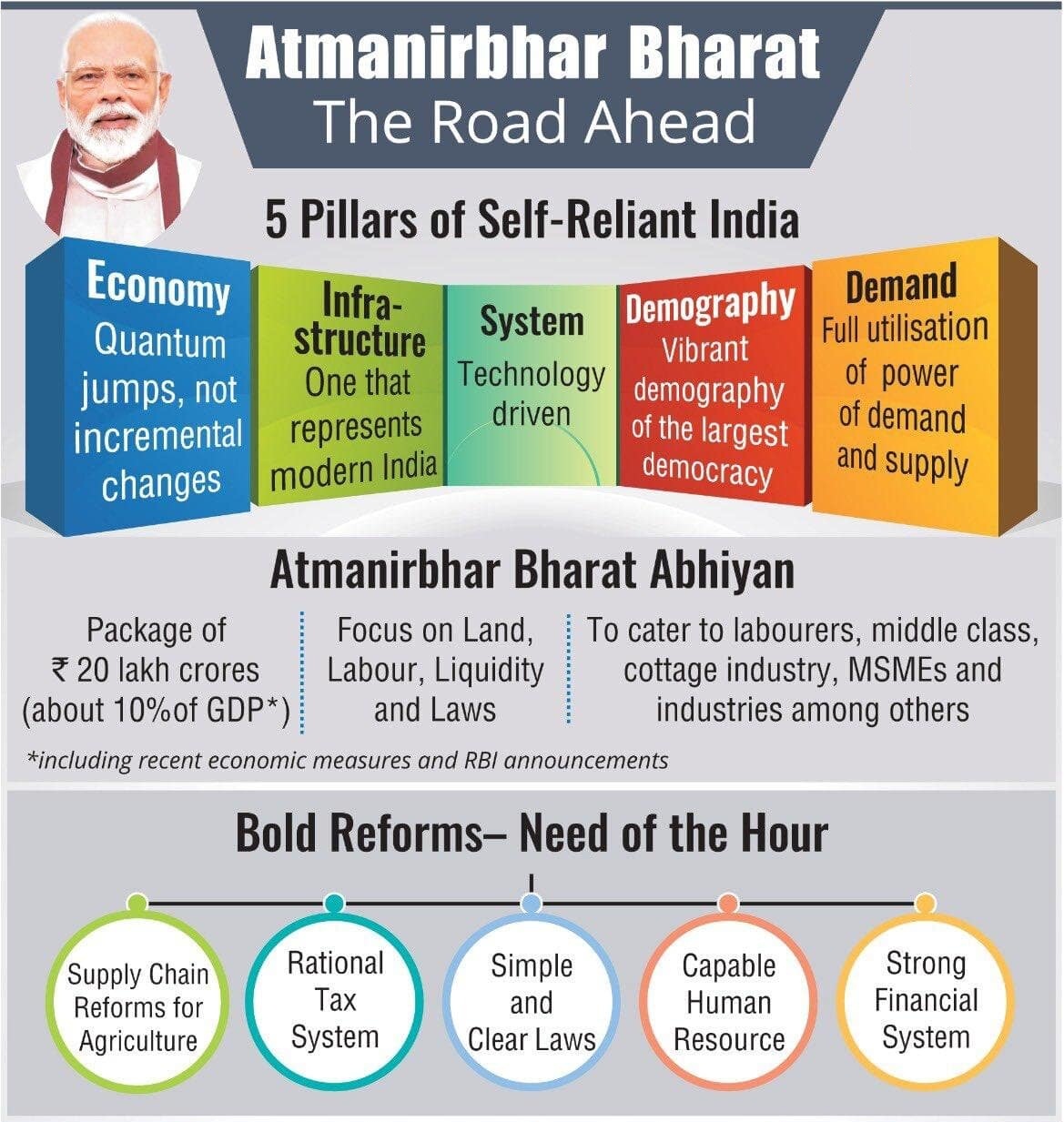Atmanirbhar Bharat Abhiyan or Self-Reliant India Mission
Prime Minister in his address on 12th May 2020 has announced the ‘Atmanirbhar Bharat Abhiyan (or Self-Reliant India Mission)’ with an economic stimulus package worth Rs 20 lakh crores aimed towards achieving the mission.

- It aims towards cutting down import dependence by focusing on substitution while improving safety compliance and quality goods to gain global market share.
- Self-Reliance neither signifies any exclusionary or isolationist strategies but involves creation of a helping hand to the whole world.
- Mission focuses on the importance of promoting “local” products.
- It will be carried out in two phases:
- Phase 1: It will consider sectors like medical textiles, electronics, plastics and toys where local manufacturing and exports can be promoted.
- Phase 2: It will consider products like gems and jewelry, pharma and steel, etc.
Five Pillars of Self-Reliant India
• Economy – aims to brings in quantum jump and not incremental jump
• Infrastructure – which should become the identity of India
• System – based on 21st century technology driven arrangements
• Vibrant Demography – which is our source of energy for a self-reliant India
• Demand -strength of our demand and supply chain should be utilized to full capacity
Atmanirbhar Bharat Abhiyan
• Package of Rs. 20 lakh crore, (about 10% of India’s GDP)
• Focus on Land, Labour, Liquidity and Laws
• To cater to labourers, middle class, cottage industry, MSMEs and industries among others
- Bold Reforms: Need of the hour
• Supply Chain Reforms for Agriculture
• Rational Tax System
• Simple and clear laws
• Capable Human Resources
- Strong Financial System
Analysis of Declared Economic Package
- Inclusion of RBIs’ Expenditure in Fiscal Package:
- The declared package is considered to be substantially less because it includes the actions of RBI as part of the government’s “fiscal” package, even though only the government controls the fiscal policy and not the RBI (which controls the ‘monetary’ policy).
- Thus, the Government expenditure and RBI’s actions are neither the same nor can they be added in this manner. And thus nowhere in the world fiscal packages are declared in this manner.
- For instance, when the US announced a relief package of $3 trillion (Rs 225 lakh crore), it only refers to the money that will be spent by the government — and does not include the expenditure of the Federal Reserve (US central bank).
- Implication of Inclusion of RBIs’ Expenditure :
- If the government is including RBI’s liquidity decisions in the calculation, then the actual fresh spending by the government could be considerably lower.
- That’s because RBI has been coming out with Long Term Repo Operation (LTRO), to infuse liquidity into the banking system worth Rs 1 lakh crore at a time. If RBI launches another LTRO of Rs 1 lakh crore, then the overall fiscal help falls by the same amount.
- The direct expenditure by a government usually includes wage subsidy or direct benefit transfer or payment of salaries, etc — immediately and necessarily stimulates the economy. In other words, that money necessarily reaches the people — either as through salary or purchase.
- But measures from RBI include credit easing— that is, making more money available to the banks so that they can lend to the broader economy — is not like government expenditure.
- In times of crisis, banks may take that money from RBI and, instead of lending it, may park it back with the RBI.
- Recently, Indian banks have parked Rs 8.5 lakh crores with the central bank. So in terms of calculations, RBI has given a stimulus of Rs 6 lakh crore. But in reality, RBI has received an even bigger amount back from the banks.
- Thus, the declared amount is 10% of GDP, but less than 5% cash outgo is expected.

